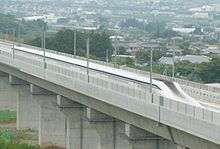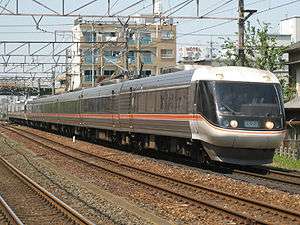L0 Series
| L0 Series | |
|---|---|
|
A test run of a five-car set, September 2013 | |
| Manufacturer | Mitsubishi Heavy Industries, Nippon Sharyo |
| Formation | 5-12 cars |
| Operator(s) | JR Central |
| Line(s) served | Chūō Shinkansen |
| Specifications | |
| Maximum speed | Operational: 505 km/h (315 mph) Record: 603 km/h (375 mph) |
The L0 Series (Japanese: L0系 Hepburn: Eru-zero-kei, "L zero series")[1] is a high-speed maglev train that the Central Japan Railway Company (JR Central) is developing and testing. JR Central plans to use the L0 Series on the Chūō Shinkansen railway line between Tokyo and Osaka, which is under construction.
The L0 Series uses the Japanese-designed SCMaglev system. Mitsubishi Heavy Industries and Nippon Sharyo, a subsidiary of JR Central, are building fourteen pre-production vehicles.[2]
A seven-car train set a land speed record for rail vehicles of 603 km/h (375 mph) on 21 April 2015.[3] The trains are planned to run at a maximum speed of 505 km/h (314 mph),[4] offering journey times of 40 minutes between Tokyo (Shinagawa Station) and Nagoya, and 1 hour 7 minutes between Tokyo and Osaka.[5]
Specifications
The end cars of L0 Series trainsets are 28 metres (92 ft) long and carry 24 passengers. The nose extends 15 metres (49 ft) for better aerodynamics and reduced noise in tunnels.[5] Intermediate cars are 24.3 metres (80 ft) long and carry 68 passengers each. Each row is four seats wide, one less than JR Central shinkansen trains. The cars are more box-shaped than earlier models to allow for more interior space.[6] Cars are painted white and blue. During normal operation, the train is expected to operate at a maximum speed of 505 km/h (314 mph).[5]
History

The first L0 series vehicle was delivered to the Yamanashi Maglev Test Line and unveiled to the press in November 2012.[7] The first five vehicles were linked up and placed on the guideway in June 2013.[6]
The first five-car train began test-running at the 42.8 km (26.6 mi) Yamanashi Maglev Test Line in June 2013, following completion of extension and upgrade work at the facility, earlier than the originally scheduled September date.[8] The maximum speed of test runs was gradually increased, reaching 500 km/h by the end of July 2013.[8]
The five-car train was lengthened to seven cars in September 2013, and test-running as a 12-car formation commenced on 25 June 2014.[9] The train was reverted to a 7-car formation later in 2014,[9] and used for public preview rides starting in November.[10]
Construction on the Chuo Shinkansen line on which the train is intended to run began in December 2014. The first section to Nagoya is expected to be completed in 2027. That section will be approximately 85% tunnels with an estimated cost of 5.5 trillion yen (US$46.5B).[11][12] The complete line to Osaka is expected to cost 9 trillion yen ($74.7 billion) and be completed by 2045. In order to help finance the project, JR Central is seeking to sell L0 series trains to foreign countries. The company is lobbying local officials in the United States to build a line between Houston and Dallas. Another possible route from Washington, D.C. to Baltimore has received political support in the United States. JR Central chairman Yoshiyuki Kasai plans to speak with U.S. President Barack Obama about the L0 Series during Prime Minister Shinzo Abe's 28 April 2015 visit.[13]
A series of endurance and speed tests were carried out on the 42.8 km (26.6 mi) test rail in April 2015 to examine the reliability and durability of the L0 after repeated high speed usage. Several speed and distance records were set in the process.[14]
Records
Speed records
- 16 April 2015: Fastest manned train in the world (590 km/h (370 mph))
- 21 April 2015: Fastest manned train in the world (603 km/h (375 mph))
On 16 April 2015, a manned seven-car L0 series trainset reached a speed of 590 km/h (370 mph), breaking the previous world record of 581 km/h (361 mph) set by a Japanese MLX01 maglev trainset in December 2003. The speed of 590 km/h was sustained for a period of 19 seconds.[15] This speed record was broken again on 21 April 2015, when a manned seven-car set recorded a top speed of 603 km/h (375 mph).[3] The train hit its top speed at 10:48 am, about 4 minutes into the run. With 49 JR Central employees on board, the train sustained the speed for 10.8 seconds, travelling 1.8 kilometres (1.1 mi) during that time.[3][13]
Distance records
- 10 April 2015: Longest distance travelled in one day (3,904 km (2,426 mi)), breaking the previous record (2,876 km (1,787 mi)) set in 2003.
- 14 April 2015: Longest distance travelled in one day (4,064 km (2,525 mi)).[11][16]
See also
References
- ↑ リニア試乗11月再開 JR東海 有料2500円程度で [JR Central to resume maglev rides - costing around 2,500 yen]. The Yamanashi Nichinichi Shimbun - Web Edition (in Japanese). Japan: The Yamanashi Nichinichi Shimbun. 20 March 2014. Retrieved 25 March 2014.
- ↑ リニア新車両は三菱重工と日本車輌製造に内定 JR東海社長 [Maglev vehicles to be built by Mitsubishi Heavy Industries and Nippon Sharyo - JR Central President] (in Japanese). Japan: Sankei Shimbun. 21 December 2010. Archived from the original on 23 December 2010. Retrieved 20 July 2013.
- 1 2 3 "Japan's maglev train breaks world speed record with 600km/h test run". The Guardian. United Kingdom: Guardian News and Media Limited. 21 April 2015. Retrieved 21 April 2015.
- ↑ JR東海:リニア時速500キロ、試験再開-通勤圏拡大で激変も [JR Central: Maglev testing at 500 km/h resumes - Expanded commuter area to create major upheavals]. Bloomberg (in Japanese). Japan: Bloomberg LP. 29 August 2013. Retrieved 12 February 2015.
- 1 2 3 "JR Tokai unveils a model for the new high-speed maglev train 'L0′". Daily Onigiri. DailyOnigiri.com. 4 November 2010. Retrieved 17 January 2013.
- 1 2 "Prototype of high-speed maglev train shown to public". Asahi Shimbun, 2013-06-03.
- ↑ リニア新型車両「L0系」を初公開 JR東海が山梨の実験線に搬入 [New L0 series maglev car unveiled, delivered to Yamanashi Test Track]. Sankei Biz (in Japanese). Japan: Sankei Digital Inc. 22 November 2012. Retrieved 22 November 2012.
- 1 2 7月中にも最高時速500キロに 新型車両「L0系」 [New L0 series trains to reach 500 km/h during July]. Chunichi Web (in Japanese). Japan: The Chunichi Shimbun. 24 July 2013. Retrieved 30 July 2013.
- 1 2 リニア、きょうからL0系試験 12両編成で走行 [Maglev L0 to start testing from today as 12-car formation]. The Yamanashi Nichinichi Shimbun - Web Edition (in Japanese). The Yamanashi Nichinichi Shimbun. 25 June 2014. Retrieved 8 August 2014.
- ↑ "Lucky riders whoosh along at 500 kph on maglev test run for the public". The Asahi Shimbun Asahi & Japan Watch. Japan: The Asahi Shimbun Company. 13 November 2014. Retrieved 17 April 2015.
- 1 2 Keith Barrow (17 April 2015). "Japan breaks maglev speed record". International Railway Journal. Retrieved 22 April 2015.
- ↑ Ichihara, Tomohiro (22 April 2015). "Japanese rail company eyes exports to cover maglev costs". Nikkei. Retrieved 22 April 2015.
- 1 2 "Japanese rail company eyes exports to cover maglev costs". Nikkei. 22 April 2015. Retrieved 22 April 2015.
- ↑ "Japanese maglev testing tops 600 km/h". Railway Gazette. 21 April 2015. Retrieved 22 April 2015.
- ↑ リニア「L0系」、世界最高の590キロ記録 [L0 series maglev sets world speed record of 590 km/h]. Yomiuri Online (in Japanese). Japan: The Yomiuri Shimbunl. 16 April 2015. Retrieved 17 April 2015.
- ↑ 「山梨リニア実験線 長距離走行試験」の結果等について [Results of distance trials at Yamanashi Maglev Test Track] (PDF) (Press release) (in Japanese). Japan: Central Japan Railway Company. 16 April 2015. Retrieved 17 April 2015.
External links
| Wikimedia Commons has media related to L0 series. |
- JR Central press release (Part 1) (26 October 2010) (Japanese)
- JR Central press release (Part 2) (26 October 2010) (Japanese)
- SCMAGLEV Website




